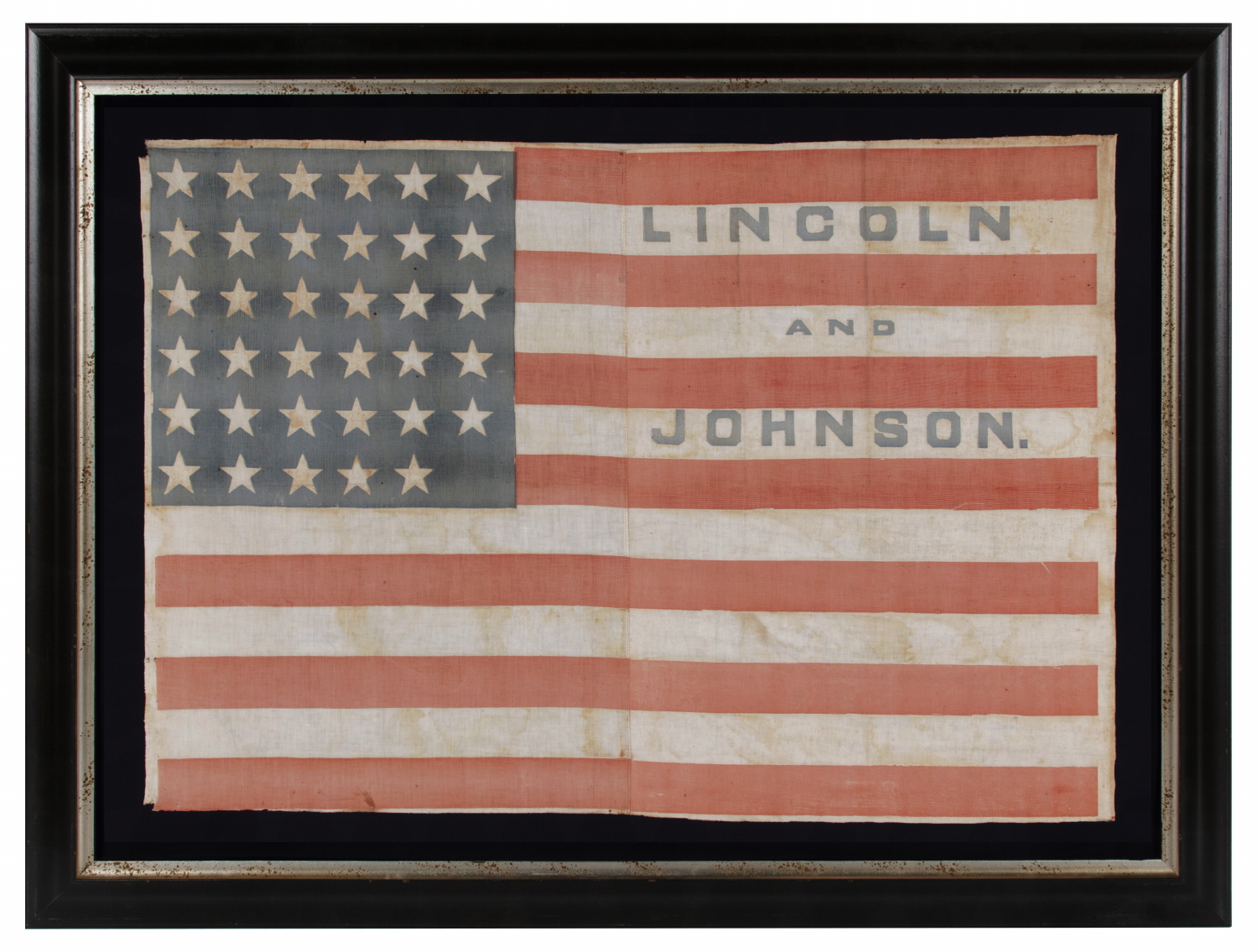
| |
35 STARS IN A NOTCHED PATTERN ON A FLAG MADE FOR THE 1864 PRESIDENTIAL CAMPAIGN OF ABRAHAM LINCOLN & ANDREW JOHNSON; A MONUMENTAL EXAMPLE AND THE SECOND TO THE LARGEST KNOWN AMONG ALL CAMPAIGN PARADE FLAGS OF THE 19TH CENTURY, ACROSS ALL ELECTIONS |
|
| Available: |
Sold |
| Frame Size (H x L): |
49" x 65" |
| Flag Size (H x L): |
36" x 52.5" |
|
| Description....: |
|
35 STARS IN A NOTCHED PATTERN ON A FLAG MADE FOR THE 1864 PRESIDENTIAL CAMPAIGN OF ABRAHAM LINCOLN & ANDREW JOHNSON; A MONUMENTAL EXAMPLE AND THE SECOND TO THE LARGEST KNOWN AMONG ALL CAMPAIGN PARADE FLAGS OF THE 19TH CENTURY, ACROSS ALL ELECTIONS:
In the world of political campaign flags, this 1864 variation is a monumental entry on the list of known examples. Made for incumbent President Abraham Lincoln, with a new running mate, Andrew Johnson, the textile is huge in scale with respect to its known counterparts. At approximately 36 x 52.5 inches, this is the second-to-the-largest surviving flag, not only across all Lincoln flags, but among all campaigns and candidates of the 19th century.
In this particular instance, in order to achieve this scale, two lengths of cotton were required. These were pieced together with a vertical seam running perpendicular to the stripes. The choice to do this is unusual and I have only encountered this construction feature on two or three other examples, all of which were in the 38 star count.
The flag's blue canton and persimmon red stripes are block printed. The names of the candidates "Lincoln and Johnson." are block printed in the same blue pigment as the canton. These appear in the first three white stripes.
The star configuration, which leaves a single star missing from the top row, is very unusual for this time period. Called a “notched” pattern, the blank space leaves little doubt that the maker of the flag assumed that Nevada would soon acquire statehood. Lincoln pushed the Silver State through 8 days before the November election, but the event was predicted well before this. I have encountered 36 star flags with hand-inscribed dates at least four months prior to when Nevada was actually admitted. This was a common theme during the late 19th century.
Across printed parade flags, none are more widely sought after than those pertaining to the two campaigns of Abraham Lincoln. There are more rare flags, such as those made for Horace Greeley, Winfield Scott, or Millard Fillmore, among which scarcely any examples have survived, but there is no 19th century American personality so beloved as Lincoln, and no series of 19th century events that have been studied more vigorously than the continued struggle for American freedom and the resulting Civil War.
Among Lincoln campaign flags, those made in 1864 are of particular interest. There are two primary reasons why. For one, fewer time and resources were available during wartime to focus on campaign accessories. In fact, it is interesting to note that of those Lincoln-Johnson flags that do exist, some were actually recycled from the 1860 campaigns of his opponents by way of applying Lincoln’s name over top on a length of cloth or paper. Such frivolity was not seen in 1860.
The other reason Lincoln & Johnson flags are more interesting is because Johnson became president following Lincoln's assassination. They therefore have the advantage of featuring the names of two American presidents instead of one. Johnson also saw the nation through the beginning of Reconstruction and played a more significant role in American history than Lincoln's first vice president, Hannibal Hamlin. So assuming all other factors are equal (graphics, text, size, etc.), the presence of the Johnson name is superior to that of Hamlin.
This is the only flag known to exist in this exact style, which adds further weight to its importance in the world of antique flags and political collecting and makes it an extraordinary addition to any collection. When this fact is added to the flag's scale, its interesting star pattern, and its importance as a Lincoln campaign textile from 1864, the result is a masterpiece among known examples.
Mounting: The flag has been hand-stitched to a background of 100% cotton twill, black in color. The black cotton was washed to remove excess dye. An acid-free agent was added to the wash to further set the dye and the fabric was heat-treated for the same purpose. A small length of fabric was placed behind the flag across the top edge to make the transition between the two sections of fabric appear more smooth from a visual perspective. The mount was placed in a black-painted, hand-gilded and distressed Italian molding with a wide ogee profile. Spacers The glazing is U.V. protective plexiglass.
Condition: There is moderate overall fading, accompanied by minor to moderate foxing and staining. There is minor fabric loss at the extreme top and bottom of the hoist end, accompanied by tiny holes along the hoist, where the flag was once tacked to a wooden staff. Many of my clients prefer early flags to show their age and history of use. The flag presents beautifully and the extreme rarity well-warrants any condition issues. |
|
|
|
| Collector Level: |
Flags for the truest Patriots. My best offerings |
|
| Flag Type: |
Parade flag |
|
| Star Count: |
35 |
|
| Earliest Date of Origin: |
1864 |
|
| Latest Date of Origin: |
1864 |
|
| State/Affiliation: |
West Virginia |
|
| War Association: |
1861-1865 Civil War |
|
| Price: |
SOLD |
|
| |
Views: 1886 |
|
|
|

